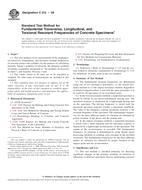Potrebujeme váš súhlas na využitie jednotlivých dát, aby sa vám okrem iného mohli ukazovať informácie týkajúce sa vašich záujmov. Súhlas udelíte kliknutím na tlačidlo „OK“.
ASTM C215-08
Standard Test Method for Fundamental Transverse, Longitudinal, and Torsional Frequencies of Concrete Specimens
Automaticky preložený názov:
Štandardná skúšobná metóda pre základné priečny , pozdĺžna , a torzné frekvenciou betónové vzorky
NORMA vydaná dňa 1.10.2008
Informácie o norme:
Označenie normy: ASTM C215-08
Poznámka: NEPLATNÁ
Dátum vydania normy: 1.10.2008
Kód tovaru: NS-12561
Počet strán: 7
Približná hmotnosť: 21 g (0.05 libier)
Krajina: Americká technická norma
Kategória: Technické normy ASTM
Anotácia textu normy ASTM C215-08 :
Keywords:
dynamic modulus of rigidity, dynamic Poisson´s ratio, dynamic Young´s modulus of elasticity, forced resonance, fundamental resonant frequency, impact resonance, nondestructive testing, Frequency measurements, Fundamental resonant frequencies, Longitudinal frequencies, Modulus of elasticity--concrete, Modulus of rigidity, Nondestructive evaluation (NDE)--concrete/masonry, Poisson&apos,s ratio, Torsional frequencies, Torsion testing, Transverse frequencies, Young&apos,s modulus
Doplňujúce informácie
| Significance and Use | ||||||||||||||
|
This test method is intended primarily for detecting significant changes in the dynamic modulus of elasticity of laboratory or field test specimens that are undergoing exposure to weathering or other types of potentially deteriorating influences. The test method may also be used to monitor the development of dynamic elastic modulus with increasing maturity of test specimens. The value of the dynamic modulus of elasticity obtained by this test method will, in general, be greater than the static modulus of elasticity obtained by using Test Method C 469. The difference depends, in part, on the strength level of the concrete. The conditions of manufacture, the moisture content, and other characteristics of the test specimens (see section on Test Specimens) materially influence the results obtained. Different computed values for the dynamic modulus of elasticity may result from widely different resonant frequencies of specimens of different sizes and shapes of the same concrete. Therefore, it is not advisable to compare results from specimens of different sizes or shapes. |
||||||||||||||
| 1. Scope | ||||||||||||||
|
1.1 This test method covers measurement of the fundamental transverse, longitudinal, and torsional resonant frequencies of concrete prisms and cylinders for the purpose of calculating dynamic Young's modulus of elasticity, the dynamic modulus of rigidity (sometimes designated as “the modulus of elasticity in shear”), and dynamic Poisson's ratio. 1.2 The values stated in SI units are to be regarded as standard. No other units of measurement are included in this standard. 1.3 This standard does not purport to address all of the safety concerns, if any, associated with its use. It is the responsibility of the user of this standard to establish appropriate safety and health practices and determine the applicability of regulatory limitations prior to use. |
||||||||||||||
| 2. Referenced Documents | ||||||||||||||
|
Odporúčame:
Aktualizácia technických noriem
Chcete mať istotu, že používate len platné technické normy?
Ponúkame Vám riešenie, ktoré Vám zaistí mesačný prehľad o aktuálnosti noriem, ktoré používate.
Chcete vedieť viac informácií ? Pozrite sa na túto stránku.




 Cookies
Cookies
